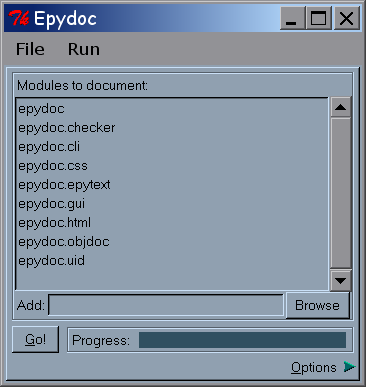
The epydoc script can be used to create API
documentation for a set of modules and packages:
epydoc [--html|--pdf] [-oDIR] [-nNAME] [-v|-q] [-uURL] [-tPAGE] [-cSHEET] [--private-cssSHEET] [--private|--no-private] [--inheritanceSTYLE]MODULES...
MODULES...os.path"), filenames (such as
"epydoc/epytext.py"), or directory names (such as
"epydoc/"). Directory names specify packages,
and are expanded to include all sub-modules and sub-packages.
--html--pdf-o DIR, --output DIR, --target DIR-n NAME, --name NAME-v, -q-v) or decrease (-q) the
verbosity of the output.-u URL, --url URL-t PAGE, --top PAGEPAGE can be the name of a module or class; a URL;
"trees.html"; "indices.html"; or
"help.html". -c SHEET, --css SHEETSHEET can be a filename, or the name of a
built-in stylesheet. For a list of the built-in stylesheets, run
"epydoc --help css".
--private-css SHEET--private, --no-private--inheritance STYLEgrouped: Inherited objects are
gathered into groups, based on which class they are inherited
from. (default for HTML output)listed: Inherited objects are
listed in a short list at the end of the summary
table. (default for PDF output)included: Inherited objects
are mixed in with non-inherited objects. For example, the following commands are used to produce the API documentation for epydoc itself:
[epydoc]$epydoc -o api --css blue --private-css green -v \ -n epydoc -u http://epydoc.sourceforge.net \ --inheritance listed src/epydoc[epydoc]$epydoc -o latex_api --pdf -n "Epydoc 2.0" src/epydoc
Note that all options must preceed the list of modules. The usage
description above does not include all options; for a complete
description of the command line usage for epydoc, see the epydoc(1) man page.
Epydoc also includes a graphical interface, for systems where
command line interfaces are not convenient (such as Windows). The
graphical interface can be invoked with the epydocgui
command, or with epydoc.pyw in the Scripts
subdirectory of the Python installation directory under Windows.

Use the "Add" box to specify what modules you wish to document.
You can specify modules using filenames (such as
"epydoc/epytext.py") or module names (such as
"os.path"). Once you have added all of the modules that
you wish to document, press the "Go!" button. Epydoc's progress will
be displayed on the progress bar.
To specify the package's name and URL, the output directory, and the CSS stylesheet, click on the "Options" arrow at the bottom of the window. This opens the options pane, which contains fields corresponding to each command line option.
![]()
The epydoc graphical interface can save and load "project files",
which record the set of modules and the options that you have
selected. Select "File→Save" to save the current
modules and options to a project file; and
"File→Open" to open a previously saved project
file.
For more information, see the epydocgui(1) man page.
The epydoc script can be used to check the
completeness of the reference documentation. In particular, it will
check that every module, class, method, and function has a
description; that every parameter has a description and a type; and
that every variable has a type. If the "-p" option is
used, then these checks are run on both public and private objects;
otherwise, the checks are only run on public objects.
epydoc --check [-p] MODULES...
MODULES...epydoc/epytext.py") or module names (such as
"os.path"). The filename for a package is its
"__init__.py" file.
-pFor each object that fails a check, epydoc will print a warning. For example, some of the warnings generated when checking the completeness of the documentation for epydoc's private objects are:
epydoc.html.HTML_Doc._dom_link_to_html........No docs epydoc.html.HTML_Doc._module..................No type epydoc.html.HTML_Doc._link_to_html.link.......No descr epydoc.html.HTML_Doc._author.return...........No type epydoc.html.HTML_Doc._author.authors..........No descr, No type epydoc.html.HTML_Doc._author.container........No descr, No type epydoc.html.HTML_Doc._base_tree.uid...........No descr, No type epydoc.html.HTML_Doc._base_tree.width.........No descr, No type epydoc.html.HTML_Doc._base_tree.postfix.......No descr, No type
If you'd like more fine-grained control over what gets checked, or
you would like to check other fields (such as the author or version),
then you should use the DocChecker
class directly.
Epydoc creates two subdirectories, for the public and private documentation. Within each subdirectory, every module and class is documented in its own file. An index file, a trees file, a help file, and a frames-based table of contents are also created. The following list describes each of the files generated by epydoc:
index.html
The standard entry point for the documentation. Normally,
index.html is a copy of the frames file
(frames.html). But if the --no-frames
option is used, then index.html is a copy of the API
documentation home page, which is normally the documentation page
for the top-level package or module (or the trees page if there is
no top-level package or module). module-module.htmlclass-class.htmltrees.html
The module and class hierarchies. indices.html
The term and identifier indices. help.html
The help page for the project. This page explains how to use and
navigate the webpage produced by epydoc. frames.html
The main frames file. Two frames on the left side of the window
contain a table of contents, and the main frame on the right side of
the window contains API documentation pages. toc.html
The top-level table of contents page. This page is displayed in the
upper-left frame of frames.html, and provides links to
the toc-everything.html and
toc-module-module.html pages. toc-everything.html
The table of contents for the entire project. This page is
displayed in the lower-left frame of frames.html, and
provides links to every class, type, exception, function, and
variable defined by the project. toc-module-module.html
The table of contents for a module. This page is displayed in the
lower-left frame of frames.html, and provides links to
every class, type, exception, function, and variable defined by the
module. module is the complete dotted name of the module, such as
sys or epydoc.epytext. epydoc.css
The CSS stylesheet used to display all HTML pages. Epydoc creates a CSS stylesheet (epydoc.css) when it
builds the API documentation for a project. You can specify which
stylesheet should be used using the -c command-line
option. If you do not specify a stylesheet, and one is already
present, epydoc will use that stylesheet; otherwise, it will use the
default stylesheet. For a list of the CSS classes used by epydoc, see
the default stylesheet.
For a description of the errors that can be generated by epydoc,
see the epydoc(1) man
page.
| [Epydoc] | [Installing] | [Epytext] | [Author] |
|